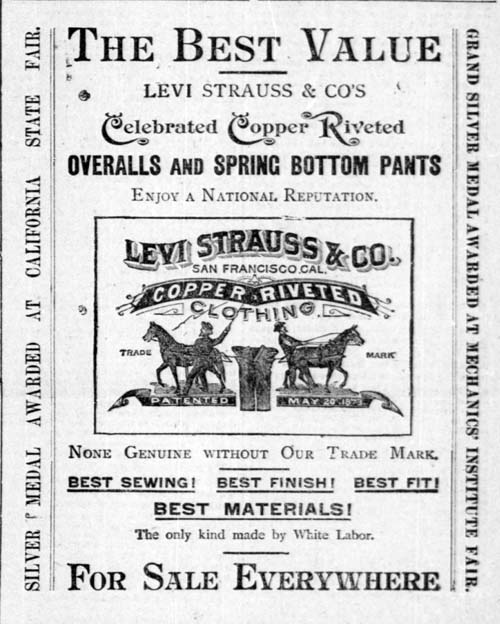VIPS in San Francisco during the 1800s
Levi Strauss
L. Straus is noted as a passenger on the following
- S.S. Lewis from San Juan del Sud, Nicaragua, October 31, 1852
- SS Tennessee from San Jual del Sud, Nicaragua, March 6, 1853
Levi Strauss was born in Buttenheim, Bavaria on February 26, 1829 to Hirsch Strauss and his second wife, Rebecca Haas Strauss; Levi had three older brothers and three older sisters.
Two years after his father succumbed to tuberculosis in 1846. In 1847, at the age of 18, Levi and his sisters emigrated to New York, where they were met by his two older brothers who owned a NYC-based wholesale dry goods business called “J. Strauss Brother & Co.” Levi soon began to learn the trade himself.
When Levi Strauss was 24, news of California's Gold Rush reached the East so Levi emigrated to San Francisco via the Isthmus of Panama and arrived in San Francisco with a small supply of dry goods with the intention of opening a branch of his brother's New York dry goods business.
In 1863, the company took the name "Levi Strauss & Co."
He continued his family's dry goods business in San Francisco where they outfitted the miners. A prospector asked what Mr. Levi Strauss was selling. When Strauss told him he had rough canvas to use for tents and wagon covers, the prospector said, "You should have brought pants!," saying he couldn t find a pair of pants strong enough to last. Levi Strauss had the canvas made into waist overalls. Miners liked the pants, but complained that they tended to chafe. Levi Strauss substituted a twilled cotton cloth from France called "serge de Nimes." The fabric later became known as denim and the pants were nicknamed blue jeans.

Strauss’s big break came in 1872, when he was approached by Jacob Davis, a Nevada tailor who had developed a new process for securing the seams of denim pants - which were already popular with miners, ranchers and farmers - by riveting them at the pockets and the base of the button fly.
Davis could not afford the $81 needed to apply for a patent for his riveting process, so he asked Strauss if he would pay the fee and share the patent. Strauss brought Davis to San Francisco to oversee the pant manufacturing. The riveted jean quickly developed a reputation for durability and quality, and Levi Strauss and Company soon employed several hundred sewing workers.
Sacramento Daily Union, December 18, 1890
NEW INCORPORATIONS
The San Joaquin Mining and the Levi Strauss Companies.
The The following articles of incorporation were filed in the Secretary of State's office yesterday: San Joaquin Mining Company of Fresno. Directors C. B. Barstow, O. B. Oleefa A. C. Bryan, H. L. Kudd and D. A. McDougald.
Levi Strauss & Co. of San Francisco. Capital stock, $1,800,000. Directors Levi Strauss, Jacob Stern, Sigmund Stern, Louis Stern and Abraham Stern.

The Levi's worked, and a successful trade became even more successful.
By his mid-thirties, Levi Strauss was a Jewish community leader, supporting San Francisco’s Temple Emanu-el and helping to fund the gold medal awarded each year to the temple’s best Sabbath School student. He was also a contributor to the Pacific Hebrew Orphan Asylum and Home, the Hebrew Board of Relief, the University of California and various other civic and cultural institutions.
Daily Alta California, March 25, 1891
The Fire Committee.
The Fire Department Committee of the Board of Supervisors met yesterday, Supervisors Coffee, Wilkinson and Burling being present. The petition of Levi Strauss for permission to erect a sign thirty feet in height on top of the buildings 1057 to 1063 Market street was taken under advisement.
San Francisco Call, June 22, 1891
FOLSOM PRISON.
Supplies Awarded by the State Prison Directors on Saturday.
Sacramento, June 21. The Prison Directors awarded contracts for various supplies to the Folsom Prison on Saturday. The San Francisco firms which were successful were: Drugs and medicines, Warden & Co., Mack & Co., Langley, Richards & Co. of San Francisco; coffees, Man, Sadler & Co., Haas Bros.; sugar, Haas Bros.; syrups, Man, Sadler & Co.; teas, Wellmann, Peck & Co.; canned goods and groceries, Haas Bros., Wellman, Peck & Co., Man, Sadler & Co. and M. Morganthau; tobacco, Drinkhouse & Co., Esberg, Boehman & Co. and Weilman, Peck & Co.; provisions, C. E. Whitney & Co.; beans, John F. English; potatoes, John F. English; flannels, cassimeres and blankets, Levi Strauss & Co.; dry goods and clothing. Murphy, Grant & Co.; crockery and glassware, Wangenheim, Stern & Co.; brooms brushes and willow-ware, Baker & Hamilton; Whlttier, Fuller & Co.; L. Feidmann & Co.; Industrial Home for Adult Blind ; stationers, H. S. Crocker & Co., and Cunningham, Curtis & Welch; hardware. Baker & Hamilton; Huntington, Hopkins & Co.
During his lifetime, Levi's estate reached $6 million. He was a (and his family still are) great philantropists. They help San Francisco and many other cities and causes around the world with their generosity.

The Annals of San Francisco, Frank Soule, John H. Gihon
1855. Written by three journalists who were witnesses to and participants in the extraordinary events they describe. The Annals of San Francisco is both an essential record for historians and a fascinating narrative for general readers. Over 100 historical engravings are included.
Partial Contents: Expeditions of Viscaino; Conduct of the Fathers towards the natives; Pious Fund of California; Colonel John C. Fremont; Insurrection of the Californians; Description of the Golden Gate; The Mission and Presidio of San Francisco; Removal of the Hudson's Bay Company; Resolutions concerning gambling; General Effects of the Gold Discoveries; Third Great Fire; Immigration diminished; The Chinese in California; Clipper Ships; Increase of population; and Commercial depression.









 Copyright ~ 1998-2018.
Copyright ~ 1998-2018. 